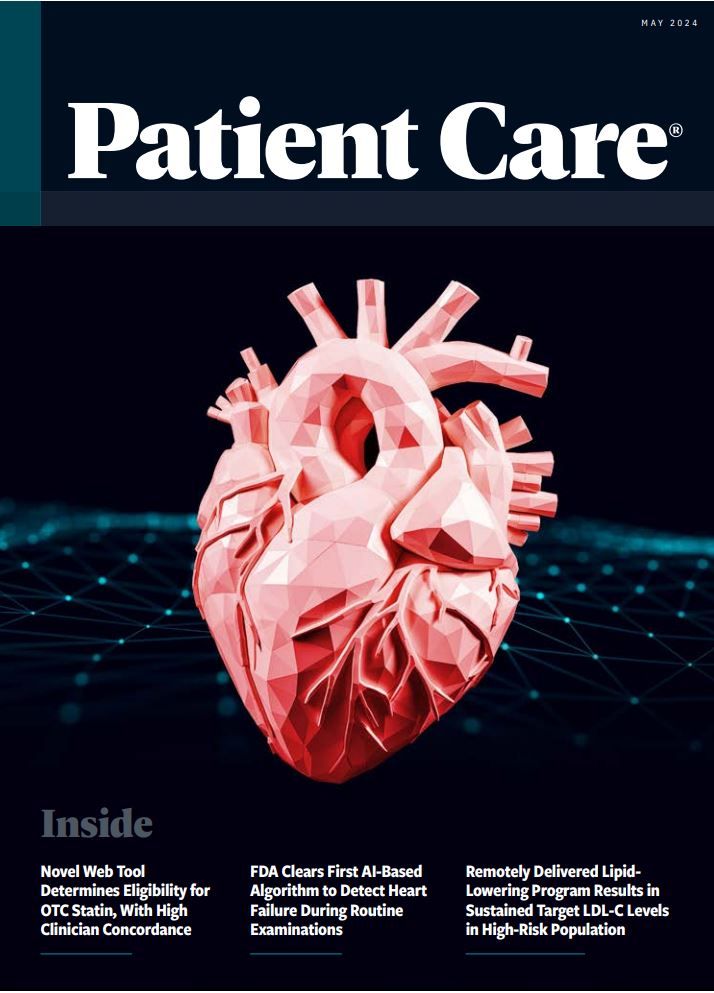- Clinical Technology
- Adult Immunization
- Hepatology
- Pediatric Immunization
- Screening
- Psychiatry
- Allergy
- Women's Health
- Cardiology
- Pediatrics
- Dermatology
- Endocrinology
- Pain Management
- Gastroenterology
- Infectious Disease
- Obesity Medicine
- Rheumatology
- Nephrology
- Neurology
- Pulmonology
Novel Web Tool Determines Consumer Eligibility for OTC Statin, With High Clinician Concordance
The web app showed more than 90% concordance with clinical assessment of eligibility for low dose rosuvastatin; study yields 35.5% reduction in LDL-C.
Steven Nissen, MD
TACTiC Lead Author
TACTiC Lead Author
“In the setting where ASCVD remains the leading cause of death in the US, the undertreatment of adults with elevated LDL-C represents a lost public health opportunity and a motivation to consider novel approaches to therapy, including direct consumer access.”

Using a novel web application, more than 90% of adult consumers correctly self-selected for treatment with a nonprescription statin, closely approximating results of clinician assessment of eligibility, according to findings of TACTiC, an actual use study presented during a late-breaking clinical trial session at the 2024 American College of Cardiology Scientific Sessions, April 6-8, 2024 and published simultaneously in the Journal of the American College of Cardiology (JACC).
Moreover, the study investigators reported that among TACTiC participants who were eligible for access to a 5 mg dose of rosuvastatin using the web-assisted approach, nearly all (98.1%) demonstrated correct use of the medication and achieved clinically meaningful LDL-C reductions of 35.5% in LDL-C 6 months after treatment was initiated. There were no safety issues reported.
The study is the first experiment with a traditionally prescribed statin medication to demonstrate that, outside of a clinical setting and in the absence of a health care professional, consumers could self-select, confirm eligibility, and take a statin appropriately, according to study authors, led by Steven E Nissen, MD, chief academic officer in the Heart, Vascular, and Thoracic Institute at Cleveland Clinic.
"Although statins reduce adverse cardiovascular outcomes, less than half of eligible patients receive treatment," Nissen et al wrote in JACC. "Multiple past attempts to address this problem through over-the-counter statins were unsuccessful in achieving regulatory approval due to concerns about inappropriate self-selection by consumers for whom statins could be unnecessary or unsafe." The authors point to this study's findings as the first step in assuaging those concerns.
The study is the first experiment with a traditionally prescribed statin medication to demonstrate that, outside of a clinical setting and in the absence of a health care professional, consumers could self-select, confirm eligibility, and take a statin appropriately.
The 6-month single arm study was designed to evaluate the safety and efficacy of the use of technology-assisted self-selection (TASS) to qualify for initial and ongoing treatment with a statin when used in an unsupervised environment. TACTiC was conducted with only virtual visits with no in person contact.
According to the authors, the web app employed for the study incorporates the 2018 Cholesterol Treatment Guidelines using the Pooled Cohort Equations to determine 10-year cardiovascular risk and includes key components of a proposed drug facts label for nonprescription rosuvastatin.
Recruitment, enrollment, endpoints
In response to advertising, 133 744 individuals were assessed for eligibility. Of these, 110 712 did not continue to the Web App or failed the pre-screen inclusion/exclusion criteria. Of the remaining 23 032 that were sent a web app link, 12 624 completed the Web App assessment; of those, 10 332 received a “Do Not Use” outcome. Of the remaining potential participants, 1196 signed an informed consent and comprised the overall study population, according to the study.
This final cohort had a median age of 63 years and was 39.6% women. Participants self-identified as White, 79.3%; Black, 11.7%; and Hispanic, 3.2%. Approximately three-quarters had completed college or equivalent education. Median LDL-C was 139.6 mg/dL, median systolic blood pressure, 130 mm Hg, and median calculated 10-year risk of atherosclerotic cardiovascular disease was 10.1%.
After a participant entered demographic information, cholesterol values, blood pressure and concomitant medications, the TASS app provided 1 of 3 possible outcomes for statin use: "Do Not Use," "Ask a Doctor" or "Ok to Use." Participants who received an outcome of ask a doctor or they could use a statin continued in the study and virtually met with a clinician to review their results and initiate a 6-month treatment course of low dose (5 mg) rosuvastatin that was delivered directly to the home. During that time, prior to each reorder of medication, participants completed an abbreviated web app assessment to ensure continued safe use of the statin; all were instructed to have LDL-C retested at any point after starting treatment. A final virtual visit and interview with a clinician was scheduled at the end of the treatment phase.
The TACTiC investigators defined 3 coprimary endpoints: the percentage of participants whose self-selection corresponded to the clinician assessment; the percentage who correctly reselected for continued use; and the mean percent change in LDL-C over the 6-month treatment period
FINDINGS
Nissen and colleagues reported high concordance (90.7%; 95% CI, 88.9 to 92.3) between the TASS app outcome for initial self-selection and the initial clinician assessment. The final use assessment was similarly high, with concordance in 98.1% (95% CI, 97.1 to 98.8). The mean percentage change in LDL-C was –35.5% (95% CI, -36.6 to -34.3) prior to the second visit with 84.5% of participants exceeding 20% LDL-C lowering. Baseline LDL-C was 139.6 mg/dL. The final LDL-C was 88.1 mg/dL, an absolute reduction of 51.4 mg/dL.
Among the study's secondary outcomes, researchers reported high medication adherence (95%) based on pill count of direct delivery of rosuvastatin and similarly high persistence (98.5%) over the 6-month treatment period. In addition, they found compliance with retesting of LCL-D was 83.3% for the full population and 92.9% for qualified at all reassessments. The investigators said that no participants experienced a "Stop Use" warning.
Serious adverse events occurred in 27 participants (2.3%), including one sudden death, but none were determined to be related to the study.
TACTIC was a 6-month study, leaving uncertain whether self-selection will lead to long-term medication adherence, wrote authors in detailing limitations of the study. Also, enrollment required the ability to read and understand English as well as access to the Internet, both of which criteria would exclude potentially large populations.
Nonetheless, Nissen and colleagues wrote: “In the setting where ASCVD remains the leading cause of death in the US, the undertreatment of adults with elevated LDL-C represents a lost public health opportunity and a motivation to consider novel approaches to therapy, including direct consumer access.”

